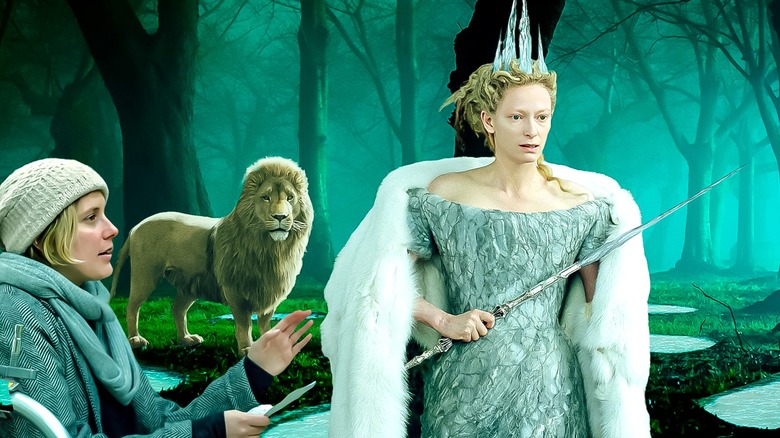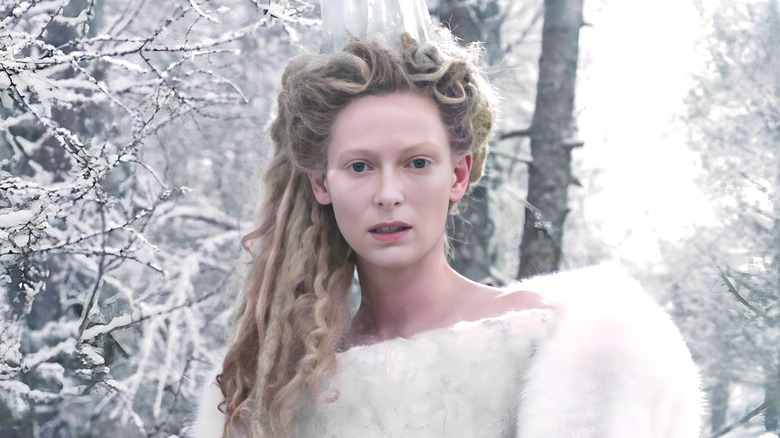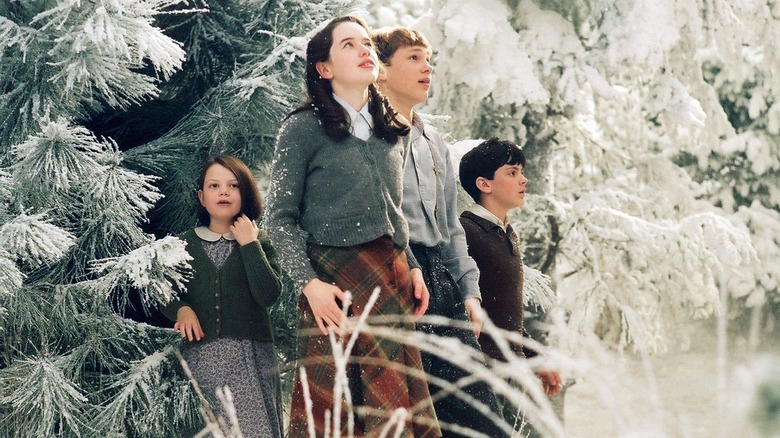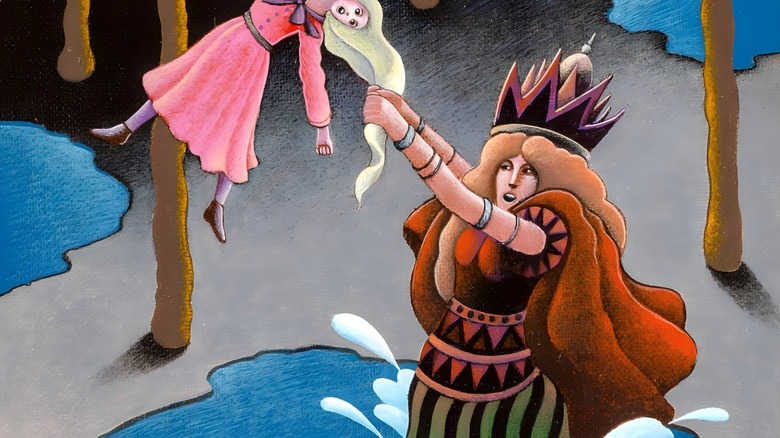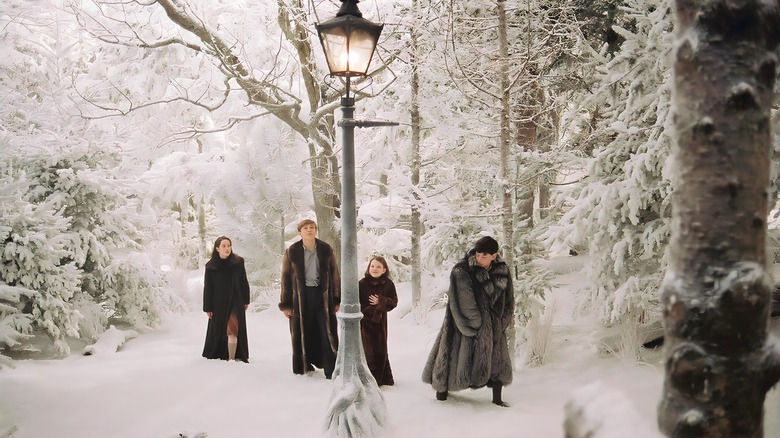Greta Gerwig's Narnia Reboot Should Skip The Wardrobe And Start With Magician's Nephew
In the lead-up to the theatrical release of "Barbie," Greta Gerwig — the film's director and co-writer — revealed an unexpected bombshell to The New Yorker.
At this time, it seems, Gerwig isn't interested in helming another toy-based story. Instead, it turns out that she has her eyes set on a different fantastical world, as tucked in the midst of the lengthy interview, the publication casually revealed that Gerwig has already signed a contract with Netflix to write and direct a brand-new adaptation of C. S. Lewis' classic fantasy series, "The Chronicles of Narnia."
On a basic level, this shouldn't come as a surprise. It's been five years since news broke that Netflix had its sights set on Narnia. The studio snapped up the rights to both films and TV series set in C.S. Lewis' imaginary world in 2018. Since then, the news cycle for Neflix's Narnia has been painfully slow. In 2019, word got out that the writer of "Coco," Matthew Aldrich, was joining the project. Since then, mum's been the word. Technically speaking, Netflix still hasn't even said anything. However, Gerwig's indirect reveal indicates that Aslan is on the move and future projects — with at least two films confirmed — appear to be coming down the pike.
The big question is this: if these movies materialize, where would a Narnia reboot begin?
The obvious answer would appear to be "The Lion, The Witch, and The Wardrobe." That's the first Narnia book to ever be published and the definitive entry point for countless fans. But it isn't the true beginning of the story. That spot is reserved for the later-published book "The Magician's Nephew," the series' underappreciated prequel — and the more you look at, the more clear it becomes that "The Magician's Nephew" is the perfect reset button.
What is C.S. Lewis' The Magician's Nephew about?
Before talking starting points, let's run over what "The Magician's Nephew" is about and how the book fits into the larger timeline of Narnia novels. Spoilers ahead!
The story of "The Magician's Nephew" takes place decades before the Pevensie children (Peter, Susan, Edmond, and Lucy, the heroes of "The Lion, the Witch, and The Wardrobe") are born, approximately at the turn of the century. We're talking about a Sherlock Holmes setting — in fact, that parallel is even made in the book. The narrative follows a pair of children, Digory Kirke and Polly Plummer, who live in London, where they stumble into a nasty adventure via the former's evil Uncle Andrew, who plays the part of the titular "Magician." To make a long story short, Uncle Andrew uses magic rings to send the children into a "world between the worlds" where they can enter into other worlds by wearing their rings and jumping into different pools of water that function as portals.
This leads the children into a dying world called Charn. They awaken an enchanted witch-queen named Jadis, who follows them first back to London, and then into an empty, uncreated world. There, they witness Aslan himself sing Narnia into existence — yes, this book features the creation of Narnia itself — and eventually, the wicked Jadis flees (though we know, of course, that she'll come back to become the White Witch). The children are sent home with a magical fruit that Digory uses to heal his sick mother. The super-powered piece of produce does the trick, the kids bury the pit, and eventually, Digory uses the magical tree to build — you guessed it — a wardrobe.
The Magician's Nephew is the true beginning of the Narnia story
Technically speaking, "The Magician's Nephew" is a prequel. It is a standalone story that sets a lot of things up for all the future Narnia books, but never connects too directly to future events. In that sense, many readers feel that "The Lion, the Witch, and the Wardrobe" is a more natural beginning to the narrative flow of Narnian epics, particularly since it introduces characters that return to play key roles in later novels, which gives the whole experience a helpful degree of continuity.
At the same time, though, the way "The Lion, the Witch, and the Wardrobe" starts feels a bit abrupt. It dives into a world where the wardrobe is already there. The Professor (played by Jim Broadbent in Disney's 2005 adaptation) cryptically makes multiple hints about past adventures in Narnia, too. While it's technically the first book and the beginning of the beloved Pevensie saga, it doesn't feel like an automatic launching point for the series. There's clearly a backstory that hasn't been explored yet.
In contrast, "The Magician's Nephew" has a clear beginning point. The second line in the book says that explicitly: "It is a very important story because it shows how all the comings and goings between our own world and the land of Narnia first began." Narnia literally doesn't even exist when "The Magician's Nephew" starts, which makes it the perfect bookend to go along with the final apocalyptic novel in the series, "The Last Battle." Sure, there's a time jump between "The Magician's Nephew" and "The Lion, the Witch, and the Wardrobe," but that isn't anything new. There's a similar time jump between "The Hobbit" and "The Lord of the Rings," for instance, and yet those two stories flow together very well.
The Magician's Nephew is a new way to introduce Narnia to audiences
One could argue that starting with "The Magician's Nephew" is riskier, in the sense that general audiences don't have the same familiarity with its narrative and setting that they have with "The Lion, the Witch, and the Wardrobe." Many people don't know anything about Digory and Polly. A 19th-century setting gives it the feel of a period piece, too. And even when the hypothetical movie does introduce Narnia, it will be as a brand-new world, without familiar reference points to guide viewers along.
This argument weakens, though, when you stop to consider how many subtle and clever throughlines there are between "The Magician's Nephew" and future books. Planting additional connections to the prequel story and a future "The Lion, the Witch, and the Wardrobe" adaptation isn't as challenging as, say, how Amazon Studios has tried to interweave its "The Rings of Power" show to the events of "The Lord of the Rings," thousands of years later. With Narnia, the gap between these two books is less than a lifetime (in our world). On top of that, "The Magician's Nephew" offers a fun and different introduction to many Narnia tropes, that would allow audiences to rediscover them on new terms. We already mentioned the construction of the wardrobe, but Digory grows up to be kind old Professor Kirke, who lets the Pevensies come and live with him to escape the danger of the air raids in London. The path by which Jadis, the wicked witch-queen of Charn, becomes none other than the White Witch is endlessly fascinating. And we even see the unexpected establishment of the very lamppost that Lucy sees burning away in the snow the first time she tumbles into Mr. Tumnus.
It's true that "The Magician's Nephew" is generally disconnected from the flowing chronicle of the later books. But it has plenty of narrative tendrils that connect it to that larger multi-story arc, all the same.
The Magician's Nephew can start a new Narnia franchise for a new generation
Along with its ideal chronological spot as the first story in the Narnia timeline, "The Magician's Nephew" has another thing going for its candidacy: it hasn't been adapted as a big-budget film yet. Both Disney's films and the BBC miniseries that preceded them started with "The Lion, the Witch, and the Wardrobe." Neither of them took time for the prequel.
This makes "The Magician's Nephew" the perfect entry point for a new series. With the unfinished business of the Disney adaptations still hanging in the air (news was still buzzing about a failed fourth film as recently as 2017), the prequel offers the perfect on-ramp for a complete reset. It would allow a new series to recast, reboot, and otherwise march to the beat of its own drum. The movie could set its own Narnian ground rules, familiarize the audience with its version of the White Witch, and leave things primed for a triumphant re-entry of the Pevensies to follow in its sequel. The ideal nature of "The Magician's Nephew" as a starting point for a reboot is nowhere more apparent than in some of the final words of the book itself. No more than a page or two from the end of the book, Lewis writes, "The lamp-post which the Witch had planted (without knowing it) shone day and night in the Narnian forest, so that the place where it grew came to be called Lantern Waste; and when, many years later, another child from our world got into Narnia, on a snowy night, she found the light still burning. And that adventure was, in a way, connected with the ones I have just been telling you."
If that isn't the blueprint for the perfect post-credits scene, we don't know what is.
